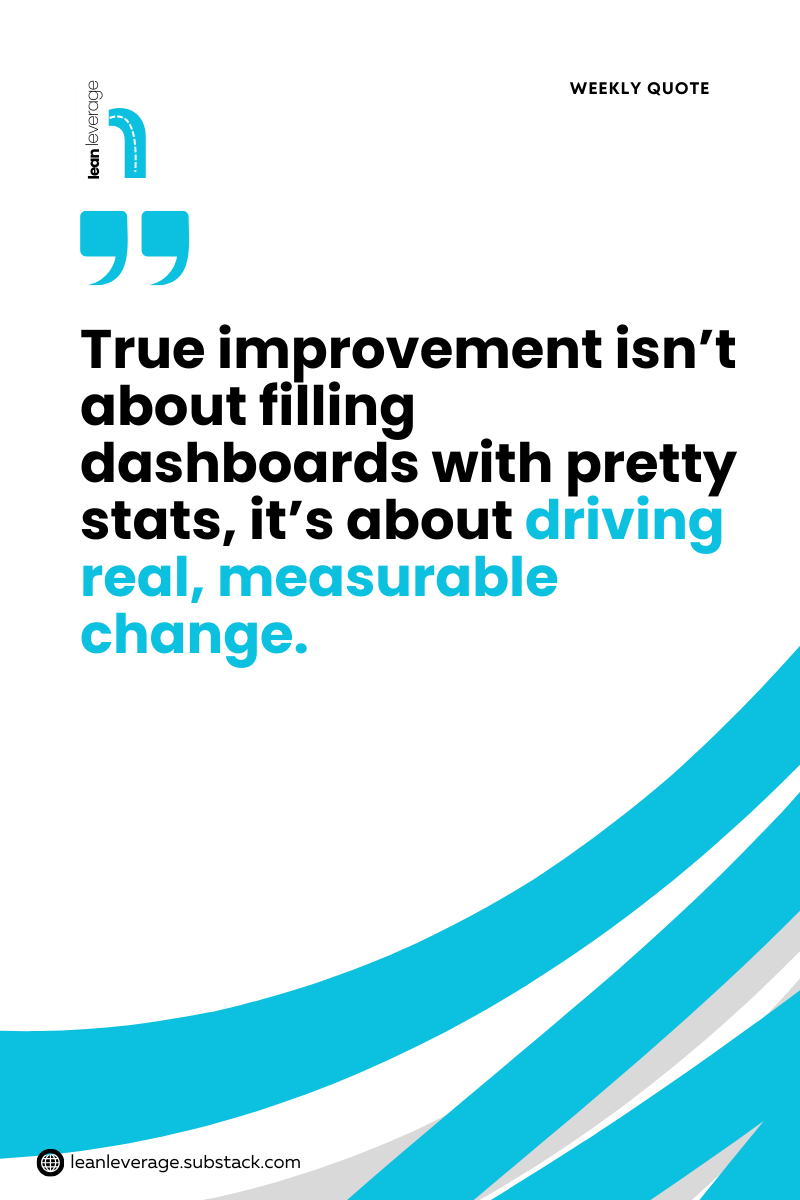Vanity Metrics: The Shiny Numbers That Lie to You
A “vanity metric” is any number or metric that gives you a false sense of success. You feel like you’re making progress, but the number isn’t tied to a meaningful outcome or decision.
Hi friends,
I ought to have written this post last week, but I got caught up with some friends I haven’t seen in four months. Four months might sound short, but for someone like me with a small circle? That’s basically a decade of gist and laughter to catch up on. So yes, today’s post is landing a bit late… but trust me, it’s worth your time. Now, let’s jump into something that pretends to be worth your time, but often isn’t: vanity metrics.
The numbers that look good, feel good, but do absolutely nothing to drive meaningful progress. If you’ve worked in improvement, operations or data for even five minutes, you’ve probably heard people whisper about them with full-on frustration. Today, we’re unpacking what vanity metrics really are, why they can derail your improvement efforts, and how to swap them out for data that actually tells you something useful.
What Are Vanity Metrics?
You know those metrics that make you look like a superstar, but deep down, you know they’re doing nothing to actually move the needle? That’s how vanity metrics roll. They look good. They sound good. But in the real world, they don’t help you improve much.
A “vanity metric” is any number or metric that gives you a false sense of success. You feel like you’re making progress, but the number isn’t tied to a meaningful outcome or decision. It’s like washing or polishing a car with no engine; you’ll shine on the outside, but you’re not going anywhere.
There’s nothing wrong with feeling proud of big numbers. But if you’re serious about real improvement? Those numbers need to tell you something useful.
How Vanity Metrics messed me up:
I remember when I was the Business Ops Manager at a fintech company in Southwest Nigeria back in 2021. Our mission was simple: provide banking services to unbanked areas using special POS devices, distributed to local agents. These agents would help people withdraw cash and earn a small commission from each transaction carried out on the device.
My job? Recruit more agents and hand out more POS devices. Simple enough, right? The logic was: more agents = more devices = more customers served.
So there I was, counting down boxes of devices in the store and literally doing a mini victory dance each time we cleared a carton. I was feeling like the star boy of business ops.
But my excitement was short-lived.
At the end of my first quarter, the regional manager pulled me aside with some sobering news: about 40% of the agents I onboarded had never used their devices, not even once. Some had lost interest, others ran out of capital, and a few struggled to find good locations for their businesses.
We were at a bit of a loss because these devices weren’t exactly free for us; the company had paid to make them, but they were handed out to agents at no purchase cost (just a small usage fee), and now we had lots of them gathering dust in the agents’ houses.
Worse still, part of our business profit came from the commission we earned on actual customer transactions. So while I was busy chasing the number of new agents onboarded—a metric that could only ever go up, we completely missed what mattered: the number and value of transactions each agent was making.
Did I lose my job? Thankfully, no. But I spent the next three months working overtime to reactivate those dormant agents and get things moving in the right direction.
That experience? A masterclass in how vanity metrics can lead you straight into a ditch.
Why Vanity Metrics Mislead Us
They’re Easy Wins.
Numbers like “total agents onboarded” or “devices distributed” are simple to track, and let’s be honest, they look fantastic on a dashboard. Every time a new agent got a POS device, it felt like a win. I was literally dancing as cartons of devices disappeared from our stockroom. Signing up agents was easy. Getting them to actually use those devices? That was the real challenge—and one I completely missed at first.They Massage the Ego.
Vanity metrics play to ego. Big numbers = big success, right? Well… not really. In my case, we onboarded loads of agents, but 40% of them never did a single transaction. It looked like we were growing fast, but underneath, there was a lot of dead weight. My reports were clapping for me, but the business wasn’t making money off inactive agents. Classic ego trap.
Two Ways to Escape the Vanity Trap
Measure What Moves the Needle.
Instead of just counting how many agents you’ve onboarded, track how many are actively transacting and the value of those transactions. The same goes for other industries. In a hospital, don’t just track how many appointments were booked. Track how many were attended and resulted in positive health outcomes.Always Ask: “So What?”
Each time you’re handed a number, pause and question it. What decision can we make from this? What problem does it help solve? If it’s not tied to action or insight, it’s just noise.
Final Thoughts: Don’t Let the Numbers Deceive You
Here’s the hard truth: not every big number deserves a high-five. True improvement isn’t about filling dashboards with pretty stats, it’s about driving real, measurable change. Vanity metrics make you feel good in the short term, but actionable metrics are what build long-term success.
So next time someone flashes a shiny report in your face, smile politely and ask:
“Nice, but what does this really mean for us?”
Until next time, keep improving.
Tomiwa.





Great read as usual Tomiwa